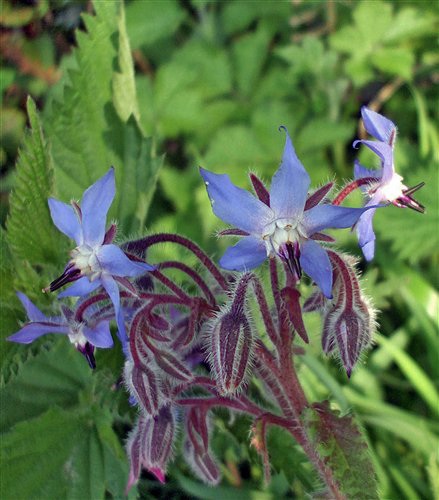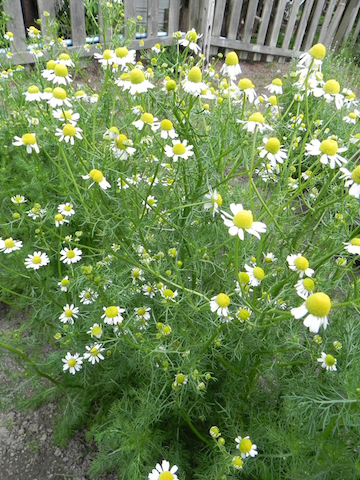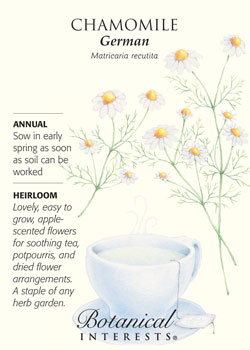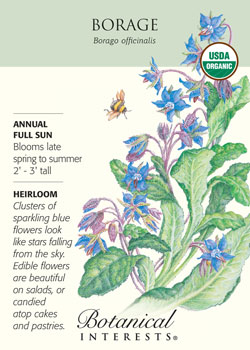While we wait for Spring to really arrive, I’m enjoying these very hardy early Spring or late Winter herbs.
In the Herb Garden the flowers I love to see in early Spring are the blue of Borage, Borago officinalis

and Chamomile, Matricaria recutita, with its tiny yellow and white daisy-like blooms.

Neither Borage nor Chamomile seem to be grown much around here. I don’t know why. Both reseed nicely without being invasive and are useful herbs, too.
Maybe because they’re not in the top five culinary herbs, they’re often forgotten.
Both herbs do well in average garden soil or in large containers. Both will reseed and can be easily grown from seed or from transplants.
I like to let Chamomile come up where it wants around the garden. It’s so cheery and sweet smelling, never invasive or unwanted in my beds.
Borage, with its rich blue flowers and large, coarse leaves is a stunning garden addition. It fills space early in the season before the weather gets too hot. Blue flowers are unusual enough that to me, Borage is very special.
The flowers are edible, too! Just remove the hairy, dark anthers to reveal the bright blue corolla. It’s fun to freeze them in ice cubes to float in lemonade or iced tea. The young leaves and cleaned flowers can be eaten fresh in salads. They have a mild cucumber flavor and a cool aftertaste. Add the chopped leaves to yogurt or sour cream for a dip.
Borage-Yogurt Dip
3 cup plain yogurt
1 clove garlic minced
3 Tbsp chopped borage
1 Tbsp chopped salad burnet
1 Tbsp chopped basil
Make a yogurt cheese: Line a sieve with a double thickness of cheesecloth, set over a bowl. Place yogurt in sieve and put sieve and bowl in refrigerator for at least 3 hours or overnight. Mix yogurt cheese with remaining ingredients in medium bowl. Refrigerate until ready to use. (Recipes from Riversong)
Therapeutically, Borage has been used for many reasons. An infusion is said to relieve lung problems and feverish colds. A syrup made from the infusion has been used as an expectorant. A poultice made from crushed leaves can sooth skin irritations. The oil from the seeds contains GLA, Gamma-Linoleic Acid, which some studies have shown to be beneficial in treatment of inflammatory diseases. One article with more information about GLA can be found at Health Library.
Borage is said to bring courage, dispell gloom and brighten one’s spirits. During the Middle Ages, women would embroider Borage leaves on scarves. The scarves were given to knights prior to a tournament or before going off to the Crusades. Young girls would serve Borage Tea to prospective suitors to encourage them to propose marriage. The plant was included in the gardens of Versailles during the reign of Louis XIV.
Contrasting with the appearance of Borage, Chamomile is a very delicate plant with a sweet, apple-like fragrance. It’s ferny leaves form a small bushy clump then bloom with the tiny flowers used in tea. It grows to about 12″ – 15″ tall and then the little flowers start to form. Harvesting for tea can be somewhat tedious as the blossoms are so small. I’ve seen a hand held rake type tool used for manual harvesting, similar to a tool used to hand harvest blueberries.

The most common type of Chamomile used for tea is called German Chamomile, Matricaria recutita. There are other types of Chamomile. One is low growing and used for landscaping. It is generally known as Roman Chamomile, Chamaemelum nobile or, under it’s older botanical designation: Anthemis nobilis. Another type is Maroc Chamomile, Chamaemelum mixtum, formerly Anthemis mixta, Ormenis mixta.
The most common use for German Chamomile is for tea. It is a soothing, calming herb with a bright, sweet flavor. Harvest the flowers before they are fully open for best flavor. Store in an air tight container.
The flowers rehydrate easily, so be sure to keep air out of the storage container or your tea could form mold. The tea has been used for centuries to calm upset stomachs, soothe nervousness and anxiety and as a hair rinse for those with light or blond hair. A double strength tea sprayed on new seedlings has promise in combatting damping off disease- a fungal disease that attacks new seedlings and causes them to fall over and die.
Chamomile is easy to grow from seed or transplants, if you can find them. It can grow in full sun to part shade with average water in well draining soil. The plant seems to be a good companion for cabbage and other brassicas since it strengthens the soil and keeps away pests. (Brassicas are notoriously heavy feeders.)
Some people who have seasonal allergies, especially to ragweed, may be allergic to Chamomile, since they are in the same Family, the Asteracea (or Compositae) Family. If you don’t know if you are allergic to Chamomile, use common sense and try a little bit to see if you have a reaction, before drinking a whole cup or two.
Chamomile Tea
Infuse 2 teaspoons of fresh, 1 teaspoon dried, Chamomile Flowers in a cup of freshly heated water for 10 minutes. Strain and enjoy!
Herbal Digestive
1 Tbsp fresh chamomile
1 Tbsp chopped mint
1 Tbsp lemon verbena
1 Tbsp lemon balm or zest from 1 lemon (no pith)
2 cloves
1 stick cinnamon
1 Tbsp coriander (crushed seeds)
1 Tbsp lavender flowers
1/4 cup sugar
Place ingredients in mason jar and pour enough brandy to cover completely or fill mason jar. Steep 4-6 weeks, strain and decant into smaller bottles. Take by droppers full or small sips for digestion.
(The Madison Herb Society Cookbook)
Chamomile Wine
1 liter dry white wine
1 cup dried chamomile flowers
grated zest of 1 orange
1 1/2 oz light rum (optional)
4 Tbsp honey (or to taste)
Pour wine into a clean glass jar or bottle. Add chamomile, orange zest and rum. Cover and steep for 1 week. Strain through a coffee filter, add honey to taste and pour it into a clean container. Seal and store for up to 1 year.
(Herb Companion, Aug/Sept 2003)
Chamomile is popular in many cosmetic preparations such as shampoo and hair rinses, salves, skin toners and in a bath.
Body & Soul: Skin Soothing Chamomile Spray
By Janice Cox
Makes 8 ounces
German chamomile (Matricaria recutita) is easy to grow almost anywhere.
This sweetly scented herb is an anti-inflammatory and antiseptic agent, helping to relieve the sting caused by too much sun or wind. You can make this skin-soothing recipe as easily as a cup of tea. (If you don t have chamomile flowers, you can make a spray from a few drops of chamomile essential oil mixed with a cup of water.)
1/2 cup fresh chamomile flowers
1 cup boiling water
In a ceramic container, pour the boiling water over the chamomile; steep for at least 1 hour. Strain out the flowers and pour liquid into a clean spray bottle or other container. To use, spray on clean skin or apply with a cotton pad. Let tea dry on your skin; do not rinse.
Janice Cox is the author of Natural Beauty from the Garden (Henry Holt and Company, 1999).
Chamomile Hair Rinse
By Janice Cox
Makes 12 ounces
This rinse is good for lightening fair hair.
2 cups water
1/4 cup fresh or dried chamomile flowers
1. Boil water and pour over chamomile flowers. Let mixture cool and then strain out all solids before using.
2. To use: Pour over clean hair as a final rinse. Do not rinse.
Janice Cox recently co-authored a book with her daughter Lauren Cox, EcoBeauty Scrubs, Rubs, Masks, and Bath Bombs for You and Your Friends (Ten Speed Press, 2009). Look for it in bookstores nationwide.
You can find both Chamomile Seeds and Borage Seeds at The Herb Cottage Herb Seed Shop

I hope you’ll give both Borage and Chamomile a try in the upcoming season.
If you live in areas other than the Gulf South of the US, you can grow both Borage and Chamomile during the summer quite well. Both are annuals and should grow well for your entire growing season from after frost to first frost.
QUOTE FOR THE MONTH
When the power of love overcomes the love of power the world will know peace.
-Jimi Hendrix, musician, singer, and songwriter (27 Nov 1942-1970)
